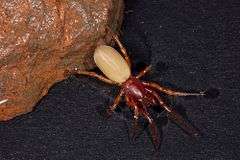Dysderidae
| Dysderidae | |
|---|---|
 | |
| female Dysdera erythrina | |
| Scientific classification | |
| Kingdom: | Animalia |
| Phylum: | Arthropoda |
| Class: | Arachnida |
| Order: | Araneae |
| Superfamily: | Dysderoidea |
| Family: | Dysderidae C. L. Koch, 1837 |
| Genera | |
|
See text | |
| Diversity | |
| 24 genera, 481 species | |
 | |
The family Dysderidae (woodlouse hunters, sowbug-eating spiders or cell spiders) are araneomorph spiders found primarily in Eurasia, although extending into North Africa, with very few species occurring in South America, and one (Dysdera crocata) introduced into many regions of the world.
Dysderids have six eyes, and are haplogyne, i.e. the females lack a sclerotized epigyne. There is a substantial number of genera, but two of them, Dysdera and Harpactea, account for a very large number of the species and are widespread across the family's range. One species, Dysdera crocata (the woodlouse hunter), has been transported over much of the planet together with its preferred foods—woodlice. Dysdera also feeds on beetles. These spiders have very large chelicerae, which they use to pierce the armored bodies of woodlice and beetles. There are also some reports that they have a mildly toxic venom that can cause local reactions in humans; with their huge fangs there is little doubt that they could bite if threatened, but the venom has not been well studied.
The spiders have their six eyes arranged in a semicircle like segestrids, but have only the first two pairs of legs produced forward. Dysdera crocata has a characteristic coloring, which can only be confused with spiders in the corinnid genera Trachelas and Meriola: the carapace is dull red-brown and the abdomen gray or tan. The "two-tone" look, with the abdomen much lighter than the cephalothorax, is quite striking.
These rather large, burly-looking, slow-moving spiders are often seen in the autumn in basements and other cool areas of homes; presumably they are looking for a winter shelter.
Genera
The categorization into subfamilies follows Joel Hallan's Biology Catalog.
- Dysderinae C. L. Koch, 1837
- Cryptoparachtes Dunin, 1992 (Georgia, Azerbaijan)
- Dysdera Latreille, 1804 (worldwide)
- Dysderella Dunin, 1992 (Azerbaijan, Turkmenistan))
- Dysderocrates Deeleman-Reinhold & Deeleman, 1988 (Balkans)
- Harpactocrates Simon, 1914 (Europe)
- Hygrocrates Deeleman-Reinhold, 1988 (Georgia, Turkey)
- Parachtes Alicata, 1964 (Southern Europe)
- Rhodera Deeleman-Reinhold, 1989 (Crete)
- Stalitochara Simon, 1913 (Algeria)
- Tedia Simon, 1882 (Israel, Syria)
- Harpacteinae
- Dasumia Thorell, 1875 (Europe, Middle East)
- Folkia Kratochvíl, 1970 (Balkans)
- Harpactea Bristowe, 1939 (Europe to Iran, Mediterranean)
- Holissus Simon, 1882 (Corsica)
- Kaemis Deeleman-Reinhold, 1993 (Italy)
- Minotauria Kulczyn'ski, 1903 (Crete)
- Sardostalita Gasparo, 1999 (Sardinia)
- Stalagtia Kratochvíl, 1970 (Balkans, Greece)
- Rhodinae
- Mesostalita Deeleman-Reinhold, 1971 (Balkans, Italy)
- Parastalita Absolon & Kratochvíl, 1932 (Bosnia-Herzegovina)
- Rhode Simon, 1882 (Mediterranean)
- Speleoharpactea Ribera, 1982 (Spain)
- Stalita Schiödte, 1847 (Balkans)
- Stalitella Absolon & Kratochvíl, 1932 (Balkans)
- incertae sedis
- Thereola Petrunkevitch, 1955 † (fossil, oligocene)
- Thereola petiolata (Koch & Berendt, 1854) †
See also
References
- Platnick, Norman I. (2008): The world spider catalog, version 8.5. American Museum of Natural History.
External links
| Wikispecies has information related to: Dysderidae |
| Wikimedia Commons has media related to Dysderidae. |